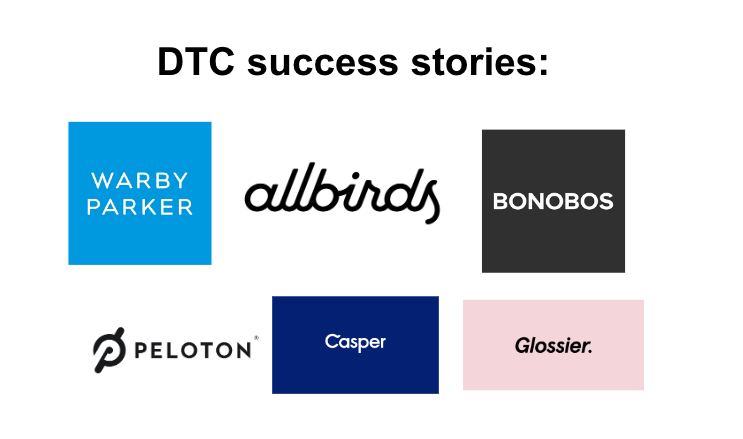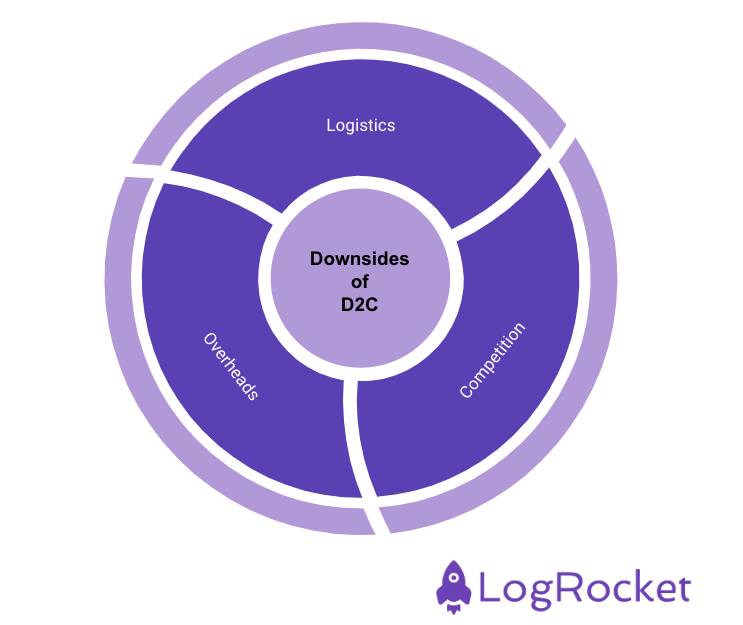Traditionally, businesses were built with a supply chain in mind. In this model, the manufacturer would build the product, before handing it over to a wholesaler or a bulk buyer, who in turn would move the product to the distributor that had a strong network of retailers (i.e shops or outlets); finally, the retailers would be the last touchpoint for the business before it changed hands and reached the end customer. The problem here is that each of these handoffs increases the end cost of the product. Every party in this format needs to have a margin in order to make the supply chain viable for business.

Direct-to-consumer (DTC or D2C) breaks this structure by radically simplifying the entire model to three steps:
In this article, you’ll learn more about the direct-to-consumer model, including key strategies, common mistakes to avoid, and the technology you can use to optimize implementation.
In the D2C model, there’s a primary assumption that the end customer is digital-first. This customer base is well-versed with digital product interactions, savvy with digital payments (if required), and comfortable with e-commerce/e-retail experience, which fundamentally changes the target audience compared to the traditional business models with more middle layers.
Since the buyer is engaging with the brand directly, your consumer insights increases multifold and your time to respond to queries or grievances shortens drastically. The D2C model even enables you to build customer archetypes because they’re much closer to your end users compared to the traditional businesses.
For instance, some of the biggest wholesalers and retailers like Target, Walmart, Costco, Lowe’s, Best Buy, Carrefour, Schwarz Group, and the e-commerce marketplaces like Amazon, Etsy, Flipkart, Alibaba are used to showcasing products by other brands. Customers often compare these retailers and e-retailers before making a buying decision.
But in the D2C model, you can reach out to customers directly. This suddenly changed the entire landscape where brands would go to customers via a digital platform — mostly a website or a mobile application, effectively skipping the wholesalers, retailers, and distributors. This is pure D2C play where the customer comes to a platform for product discovery, places an order with the brand directly and the brand delivers it (either through in-house logistics or a third-party collaboration) directly to the consumer.
The D2C model unlocks a plethora of benefits for both your brand and the consumer. Let me list some of them for you:
The opportunity for the D2C space is booming. Data suggests that by 2024, digital native brands (ones that started digital only and have digital presence), will drive more than 20 percent of all D2C sales (total sales at $210 billion) in the US. This represents twice the growth from 2020 where the D2C sales volume (cumulatively) stood at $100 billion.
Some successful D2C brands in the US are Bonobos for trousers and pants, Peloton for home-based health and fitness studio set-up, Allbirds for shoes, Warby Parker for eye-wear, Glossier for cosmetics and beauty products, Casper for premium sleep products, and many more!

Yes, there are! Most of these are tried and tested methods for the brands I mentioned above. That said, innovation is key and sometimes the strategy, whether it’s pricing or go-to-market, becomes the differentiator for a similar product offering.
Let’s look at some of the trends in D2C business strategies:
Unfortunately, nothing in life is! Oftentimes the downsides of D2C are overshadowed by the success stories you hear from brands. Despite the upsides, there are three legitimate downsides to building a D2C brand:

As a solo brand and especially if you’re not one of those with deep pockets, you’ll be challenged to manage all of your logistics by yourself. Think of inventory management, delivery, after-sales customer help desks, and so on.
You must be willing to take into account all of these before you decide to jump on the D2C success story. You can initially partner with third party operators to get going and then try to build it in-house. However, the latter may end up getting costlier and also deviate your attention from your core product/business.
Remember, D2C brands still have competition from the bigger retailers and e-retailers. If you don’t have a solid pricing strategy and payment options that your business can manage, you’ll be exposed to an exodus of your customer base to other brands and businesses who make those available.
Keep studying market trends and watch what other brands are doing. If you find a trending model that’s really picking up, you have the ability to test it out because you’re in charge of the entire brand experience.
This is the most important one! Imagine getting your website or mobile application built and creating a flywheel that ensures brand growth. From people, to the process, and even the product infrastructure, you’ll have a considerable amount of overhead problems.
Leverage technology to do all of this for you. You don’t have to learn how to code when you’re planning to sell water-resistant cotton t-shirts. Stay frugal and find collaborators.
Data…data…data. This is the key to the significant growth that you see in the D2C space. The tech platforms help support your backend. These solutions include the user facing website or mobile application, to the inventory management system in the back end, to the customer service desk where you can seamlessly raise & resolve tickets. The entire experience should be digital native.
To have a successful D2C brand, you need to be well-versed with digital marketing strategies. This will enable you to leverage social media and run campaigns or ads to get the eyeballs required to build a brand.
D2C enables you to reach out to your customers directly while controlling the entire brand purchase and after sales experience. To achieve this though, you need to focus on your pricing, delivery, social-media marketing, and loyalty programs.
There are a lot of D2C success stories out there, but building one isn’t an easy job. One needs to be mindful of logistics, competition, market penetration, and overheads. Leveraging technology (website, apps, platforms) and the data within is imperative, as is digital marketing and advertising campaigns for acquiring and retaining customers.
Featured image source: IconScout

LogRocket identifies friction points in the user experience so you can make informed decisions about product and design changes that must happen to hit your goals.
With LogRocket, you can understand the scope of the issues affecting your product and prioritize the changes that need to be made. LogRocket simplifies workflows by allowing Engineering, Product, UX, and Design teams to work from the same data as you, eliminating any confusion about what needs to be done.
Get your teams on the same page — try LogRocket today.

A practical framework for PMs to use AI in ideation without sacrificing judgment, strategy, or decision quality.

A practical five minute revenue estimation method to help product managers compare ideas, drop low impact features, and prioritize smarter.

A practical guide for PMs who want to stop being bottlenecks, delegate smarter, and lead teams effectively with a clear ownership framework.

Stop letting unreliable data block features. Treat data as inventory to track quality, ownership, and ship with confidence.